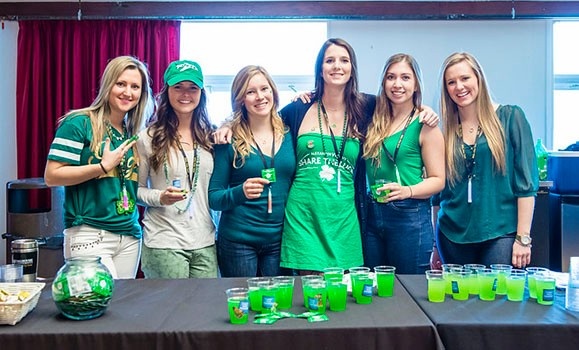You’ve likely seen the team around campus, perhaps giving out free hugs at exam time or playing “Fatal Vision” during Orientation Week. But what exactly is Student Health Promotion?
In a nutshell, SHP is a resource to other resources that offers peer-to-peer wellness support for Dal students, focused on three main areas: sexual health, mental health, and drugs and alcohol. The team is comprised of students trained in reflective listening and motivational techniques so they can help inform and direct their peers to campus resources. They promote ways students can make informed decisions about their lifestyle through outreach booths and workshops. For example, at the end of each term SHP runs workshops on how to reduce stress and hands out stress kits with information directing students to resources on campus
A year ago, in March 2013, Student Services took part in the National College Health Assessment (NCHA) survey — and will use it again in 2016 — to find out about a variety of student health issues, including alcohol use. The survey asked, “How many drinks of alcohol do you think the typical student at your school had the last time he/she partied/socialized?” The responses from Dal students weren’t encouraging: 19% said one to four drinks, and 70% said five to 10 drinks. What does that mean? Most Dal students drink, and a lot of them drink to excess.
Derrick Enslow, SHP’s program manager of Student Health Promotion, defines binge drinking as four to five drinks in a sitting for females and five to six drinks for males.
Wearing beer goggles to raise awareness
Ěý
Although most Dal students drink, 92 per cent of the survey respondents said their health is good to excellent. So throughout the year the SHP team sets up booths and hold events around campus to raise awareness about alcohol consumption, in particular binge drinking, and the effects it has on your health. Fatal Vision or “beer goggles” are sometimes used to illustrate the impact of various levels of intoxication. When students put the goggles on when their brains are sober, their vision becomes blurred and they often start to feel nauseous. But when they’re drunk they don’t realize it because their brain is impaired. “In a way it gets students thinking about how much they drink and what their limits are,” says Derrick.
Sometimes the team will get students to pour out how much they would drink in an average night and then use a standard drink size cup to measure the actual amount. “Some will say they have five, six, or seven drinks,” says Derrick. “When you measure it out it will be 10, 12, or 13 drinks. Of course, that leads to higher levels of intoxication.”
Although Derrick isn’t entirely sure how much of an impact these workshops and booths have on reducing high-risk drinking at Dal, he believes it creates an awareness of harms associated with it and helps promote healthier living.
“There are a large number of students who don’t want to go out drinking every Thursday, Friday, and Saturday night,” says Derrick. “They’re looking for other things to do, either on campus or off.” So SHP often teams up with Dal After Dark to provide alternative activities for those looking for something different — something alcohol-free. On St. Patrick’s Day, for example, Dal After Dark hosted an afternoon of games in the McInnes Room, with the SHP team serving free mocktails and running a Wii Fit station.
That’s a mighty expensive drink
Ěý
While SHP focuses on the healthy living aspect of alcohol consumption, it also works in tandem with other university units to inform students on other consequences. With the manager of Student Dispute Resolution, the legal ramifications of excessive drinking are highlighted.
Currently, students caught with a drinking-related offence — such as drinking under age — are given a $457.41 ticket and warning. However, those caught and ticketed by the police for having open liquor, causing a disturbance, or destruction of property, will go through the . Next year the program will include educational sessions focused on high-risk drinking and how to avoid it in the future. An online component will also be introduced, with alcohol assessment tools for students who think they may have a drinking problem. It will include links to various support resources.
Currently located on the fourth floor of the Student Union Building, SHP will be moving this summer across the street into the LeMarchant Mixed-Use Building. In its new digs on the second floor beside Health Services and Counselling Services, the team will be an integral part of Dal’s new centre for student health and wellness.

